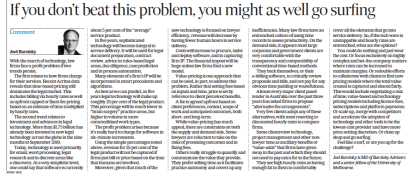With the march of technology, law firms face a profit problem if two trends persist.
The first trend relates to how firms charge for their services. Recent Acritas data reveals that time-based pricing still predominates across the legal market. This includes both billing retrospectively via hourly rates as well as upfront capped or fixed-fee pricing based simply on an estimate of time multiplied by hourly rates.
The second trend relates to investment and advances in legal technology. Over $1.75 Billion has already been invested in new legal technology across the globe in the nine months to September 2019.

Today, technology is used primarily for email, word processing, legal research and in discrete areas like e-discovery. At a very simplistic level, one could say that software is currently about 5% of the “average” service product.
In five years, sophisticated technology will become integral to service delivery. It will be used legal document preparation, contract review, advice in rules-based legal areas, due diligence, case prediction and in process automation. Many elements of a firm’s IP will be incorporated into smart precedents and algorithms.
As best as we can predict, in five years legal technology will make up roughly 25% of the legal product. This percentage will be much lower in brain surgery practice areas, but higher in volume more commoditised work types.
The profit problem arises because it’s really hard to charge for software in 6-minute increments!
Using the simple percentages noted above, revenue for 25% of the legal product will not be captured if firms just bill or price based on the time that humans are involved.
Moreover, given that much of the new technology is focused on lawyer efficiency, revenue will decrease by having fewer human hours in service delivery. Costs will increase to procure, tailor and deploy software, and in capturing firm IP.
Find a new model
The financial impost will be huge unless law firms find a new model.
Value-pricing is one approach that can be used, in part, to address this problem. Rather than setting fees based on inputs and time, price is set by reference to client perceived benefits. A fee is agreed to upfront based on client preferences, context, the scope of work and anticipated outcomes, both short- and long-term.
While value-pricing has much appeal, there are constraints on both the supply and demand side. Some lawyers are reluctant to take on the risks of promising outcomes and in fixing fees. Others really struggle to quantify and communicate the value they provide. They prefer selling time as it facilitates practice autonomy and it covers up any inefficiencies. Many law firms have an entrenched culture of using time records to assess productivity.
On the demand side, it appears most large corporate and government clients are very comfortable with the transparency and comparability of conventional time-based methods. They back themselves, or their e-billing software, to critically review proposals and bills, and not pay for any obvious time padding or wastefulness.
Almost every major client panel tender in Australia over the past three years has asked firms to propose “alternative fee arrangements”. Very few clients adopt any of these alternatives and most resort to discounted hourly rates to compare firms and to pay for services rendered.
Enough fat
Some clients view technology, project management and other non-lawyer time as ancillary benefits or ‘value-adds’ that firms have given away in the past and they should not need to pay extra for in the future. They see high hourly rates as having enough fat in them to comfortably cover all the elements that go into service delivery.
So, if the tech wave is unstoppable and hourly rates are entrenched, what options are on the table for?
- Do nothing and just wear the cost.
- Focus exclusively on highly complex and bet-the-company matters where rates can be increased to maintain margins.
- Redouble efforts to collaborate with clients to find new pricing models where the total value created is captured and shared fairly. This would include negotiating a mix of time, value-based and technology pricing models including license fees, subscriptions and platform payments.
- Scale-up, merge with competitors and accelerate the adoption of technology and other tools to be the lowest cost provider and have more price-setting discretion.
- Close-up shop and go surfing.
Feel like a surf, or are you up for the challenge?
Author
 Joel Barolsky is Managing Director of Barolsky Advisors, a Senior Fellow of The University of Melbourne and a Teaching Fellow on the Master of Legal Business in the College of Law.
Joel Barolsky is Managing Director of Barolsky Advisors, a Senior Fellow of The University of Melbourne and a Teaching Fellow on the Master of Legal Business in the College of Law.
Joel has worked with over 100 of Australia and New Zealand’s top professional service firms as a strategy advisor and facilitator.
Joel was a Principal of Beaton Research + Consulting for many years. For further details go to http://www.barolskyadvisors.com.


Very interesting article, Joel. One thing I still don’t understand regarding lawyers wearing the cost for sticking with billable hours is the prevalence of write-downs. Aren’t write downs a form of de facto value-pricing? If you work 10 hours but can only realize 7, wouldn’t technology enabling you to do the job in 8 hours make you more profitable?